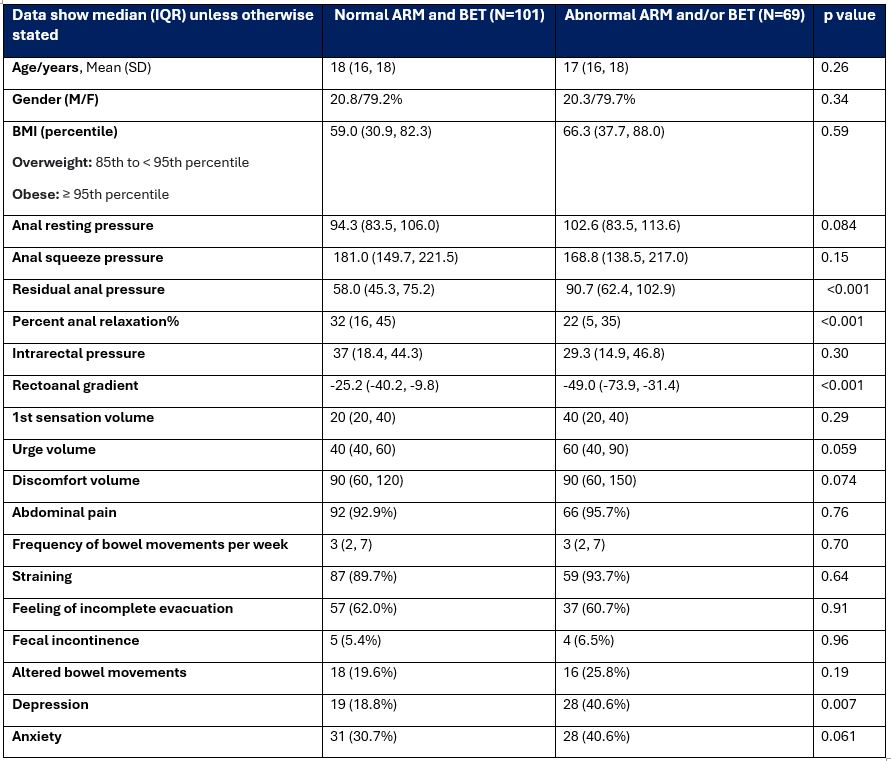Sunday Poster Session
Category: Pediatrics
P1890 - Characterization of Manometric Findings in Adolescent Patients With Dyssynergic Defecation
Sunday, October 26, 2025
3:30 PM - 7:00 PM PDT
Location: Exhibit Hall

Mustafa Sadek, MD
NCH Healthcare System
Naples, FL
Presenting Author(s)
Award: ACG Presidential Poster Award
Mustafa Sadek, MD1, Yamen Ezaizi, MD2, Alaa Almallouhi, MD3, Olla Darwish, MD2, Mhd Louai Manini, MD2, Kristin Cole, MS2
1NCH Healthcare System, Naples, FL; 2Mayo Clinic, Rochester, MN; 3Mayo Clinic, Naples, FL
Introduction: Dyssynergic defecation (DD) is a common but often underdiagnosed cause of constipation in children and adults. Diagnosis typically involves anorectal manometry (ARM) and rectal evacuation tests such as balloon expulsion time (BET), barium, or MR defecography. This study aims to describe and compare anorectal manometry findings in constipated adolescents with and without DD.
Methods: We retrospectively reviewed records of patients ≤18 years old who underwent ARM and/or BET between 2008 and 2019. Patients with prior pelvic floor therapy, inflammatory bowel disease, or colon surgery (e.g., ostomy, colectomy) were excluded. DD was diagnosed based on abnormal ARM (paradoxical anal contraction or inadequate anal relaxation [≤20%] during simulated evacuation) and/or an abnormal BET ( >60 seconds). Manometric parameters were compared between patients with and without DD, and between those with abnormal vs. normal BET. We assessed performance of various rectoanal gradient cut-offs determining abnormal BET sensitivity, specificity, positive predictive value (PPV), and negative predictive value (NPV). Wilcoxon rank sum tests compared continuous variables, and Chi-square or Fisher’s exact tests compared categorical data between groups.
Results: Of 187 adolescents with constipation, 69 (36.9%) met criteria for DD. The median age was 17 years (IQR 16–18), and 80.7% were female. Gastrointestinal symptoms did not differ between groups. Patients with DD had a significantly more negative rectoanal pressure gradient than those without DD [median (IQR): -49 mmHg (-73.9, -31.4) vs. -25.2 mmHg (-40.2, -9.8); p < 0.001]. Volume thresholds for first sensation, urge, and discomfort were similar. A rectoanal gradient cutoff of -45 mmHg showed the best predictive value for DD (sensitivity 58%, specificity 86%). Patients with DD also had significantly higher rates of depression (p < 0.05). Similarly, those with abnormal BET had more negative rectoanal gradients than those with normal BET [median (IQR): -48.6 mmHg (-79.5, -33.2) vs. -29.4 mmHg (-53.2, -13.4); p < 0.001].
Discussion: In this cohort, over one-third met criteria for DD, underscoring its clinical relevance in this population. The rectoanal pressure gradient appears to be a useful manometric parameter for identifying DD in constipated adolescents, particularly when BET is unavailable. Psychological factors such as depression may also be more prevalent in this group, highlighting the importance of psychosocial screening in adolescents with constipation.

Figure: Table 1: Demographics, Symptoms and Co-morbidities.

Figure: Table 2: Results of anorectal manometry.
Disclosures:
Mustafa Sadek indicated no relevant financial relationships.
Yamen Ezaizi indicated no relevant financial relationships.
Alaa Almallouhi indicated no relevant financial relationships.
Olla Darwish indicated no relevant financial relationships.
Mhd Louai Manini indicated no relevant financial relationships.
Kristin Cole indicated no relevant financial relationships.
Mustafa Sadek, MD1, Yamen Ezaizi, MD2, Alaa Almallouhi, MD3, Olla Darwish, MD2, Mhd Louai Manini, MD2, Kristin Cole, MS2. P1890 - Characterization of Manometric Findings in Adolescent Patients With Dyssynergic Defecation, ACG 2025 Annual Scientific Meeting Abstracts. Phoenix, AZ: American College of Gastroenterology.
Mustafa Sadek, MD1, Yamen Ezaizi, MD2, Alaa Almallouhi, MD3, Olla Darwish, MD2, Mhd Louai Manini, MD2, Kristin Cole, MS2
1NCH Healthcare System, Naples, FL; 2Mayo Clinic, Rochester, MN; 3Mayo Clinic, Naples, FL
Introduction: Dyssynergic defecation (DD) is a common but often underdiagnosed cause of constipation in children and adults. Diagnosis typically involves anorectal manometry (ARM) and rectal evacuation tests such as balloon expulsion time (BET), barium, or MR defecography. This study aims to describe and compare anorectal manometry findings in constipated adolescents with and without DD.
Methods: We retrospectively reviewed records of patients ≤18 years old who underwent ARM and/or BET between 2008 and 2019. Patients with prior pelvic floor therapy, inflammatory bowel disease, or colon surgery (e.g., ostomy, colectomy) were excluded. DD was diagnosed based on abnormal ARM (paradoxical anal contraction or inadequate anal relaxation [≤20%] during simulated evacuation) and/or an abnormal BET ( >60 seconds). Manometric parameters were compared between patients with and without DD, and between those with abnormal vs. normal BET. We assessed performance of various rectoanal gradient cut-offs determining abnormal BET sensitivity, specificity, positive predictive value (PPV), and negative predictive value (NPV). Wilcoxon rank sum tests compared continuous variables, and Chi-square or Fisher’s exact tests compared categorical data between groups.
Results: Of 187 adolescents with constipation, 69 (36.9%) met criteria for DD. The median age was 17 years (IQR 16–18), and 80.7% were female. Gastrointestinal symptoms did not differ between groups. Patients with DD had a significantly more negative rectoanal pressure gradient than those without DD [median (IQR): -49 mmHg (-73.9, -31.4) vs. -25.2 mmHg (-40.2, -9.8); p < 0.001]. Volume thresholds for first sensation, urge, and discomfort were similar. A rectoanal gradient cutoff of -45 mmHg showed the best predictive value for DD (sensitivity 58%, specificity 86%). Patients with DD also had significantly higher rates of depression (p < 0.05). Similarly, those with abnormal BET had more negative rectoanal gradients than those with normal BET [median (IQR): -48.6 mmHg (-79.5, -33.2) vs. -29.4 mmHg (-53.2, -13.4); p < 0.001].
Discussion: In this cohort, over one-third met criteria for DD, underscoring its clinical relevance in this population. The rectoanal pressure gradient appears to be a useful manometric parameter for identifying DD in constipated adolescents, particularly when BET is unavailable. Psychological factors such as depression may also be more prevalent in this group, highlighting the importance of psychosocial screening in adolescents with constipation.

Figure: Table 1: Demographics, Symptoms and Co-morbidities.

Figure: Table 2: Results of anorectal manometry.
Disclosures:
Mustafa Sadek indicated no relevant financial relationships.
Yamen Ezaizi indicated no relevant financial relationships.
Alaa Almallouhi indicated no relevant financial relationships.
Olla Darwish indicated no relevant financial relationships.
Mhd Louai Manini indicated no relevant financial relationships.
Kristin Cole indicated no relevant financial relationships.
Mustafa Sadek, MD1, Yamen Ezaizi, MD2, Alaa Almallouhi, MD3, Olla Darwish, MD2, Mhd Louai Manini, MD2, Kristin Cole, MS2. P1890 - Characterization of Manometric Findings in Adolescent Patients With Dyssynergic Defecation, ACG 2025 Annual Scientific Meeting Abstracts. Phoenix, AZ: American College of Gastroenterology.

